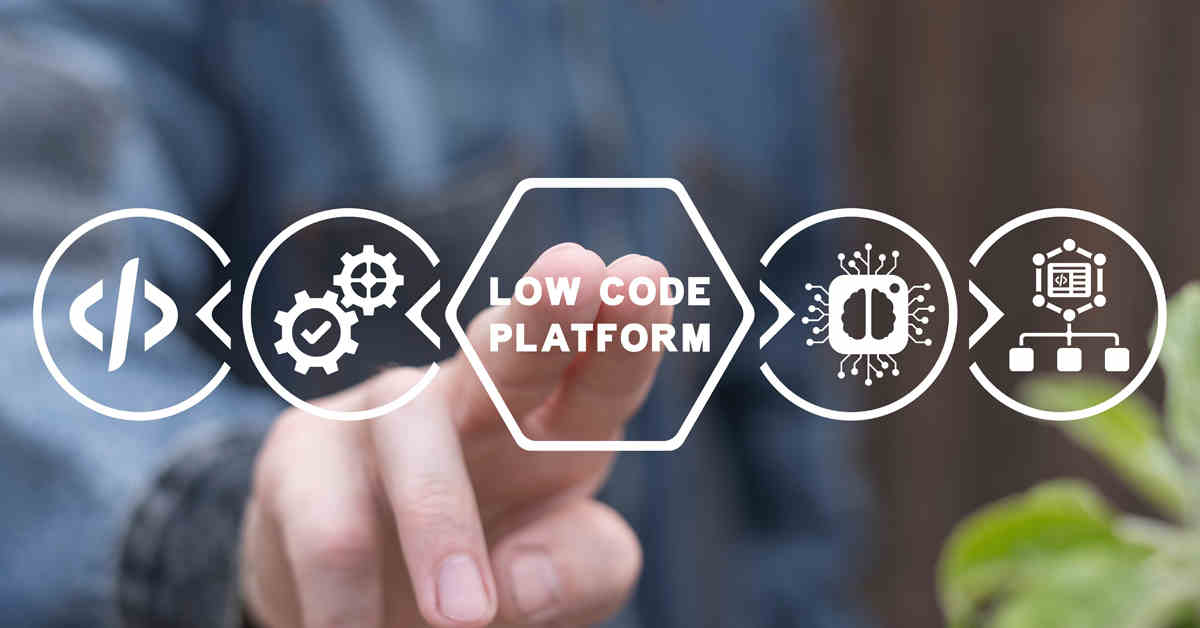Due to a number of factors, Low-code Application Development is accessible to people who are not developers. They are also known as "citizen designers."
Drag-and-Drop Builders: Low-code systems feature drag-and-drop interfaces which allow non-developers to create applications visually without writing code. This makes the process of developing easier for people with technical background.
WYSIWYG Editors: "What You See Is What You Get" editors enable users to design interfaces and workflows in a manner that closely resembles the actual product, which makes it simpler to use and understand.
Simplified Logic and Workflow Design:
Visual Workflow modeling: Users create business flows and application logic using visual flowcharts. These models are easier to work with than traditional code methods.
Pre-built Logic Components: Low-code platforms often have pre-built logic elements (e.g. statements that are conditional, loops) that can be easily modified, eliminating the requirement for complicated coding.
Reusable Components and Templates
Templates for libraries of pre-built templates Numerous low-code platforms have libraries that covers the most popular types of applications, providing non-developers a solid base to build on and later customize.
Reusable Modules and Widgets: With the help of the reuse of modules and widgets users can speed up the creation process and reduce the requirement for technical knowledge.
Guided Development and Tutorials
Step-by-Step Guides: Platforms usually offer a set of development guides as well as tutorials and on-screen guidelines to assist novice developers in building applications.
Interactive Tutorials Interactive tutorials are hands-on and interactive that allow users to learn by doing. This improves the confidence of users in the platform.
Integration with existing tools:
Seamless Integration - Low-code systems can be easily integrated with existing systems and business tools (e.g. ERP CRM) which gives even non-developers to create apps that fit to their workflows.
APIs and Connectors Built-in APIs and connectors make it easier to integrate the process and allow non-developers to connect their apps with external services, without requiring the need for complicated programming.
Collaboration Features:
Team Collaboration Features, like real time collaboration and shared workspaces, allow professionals and non-developers to collaborate effectively.
Role-based Access Control: You can give non-developers certain roles with the appropriate access level, so they are able to participate in the development process while not compromising on security or functionality.
Automated testing and debugging:
Low-code platforms usually come with integrated testing and debugging tool that simplifies the process. Non-developers can now easily ensure their application works correctly.
Error Highlighting - When problems arise, the platform highlights the issue and offers solutions, guiding users through troubleshooting.
The ability of low-code applications to facilitate development for those who are not developers is its main benefit. Platforms that use low-code empower business users with intuitive, visual and guided tools. They can then actively participate in developing and maintaining applications. View the top rated Low-code Platform for application development for site examples including cross platform app development, push alerts, azure sql databases, no code platforms, cross platform mobile dev, app dev platform, develop web app, develop mobile application, rapid action development, cross platform mobile dev and more.

Benefits Of Low Code Application Development For Governance And Security
Low-code development can bring many advantages in terms of security and governance. They are essential for ensuring applications are secure, compliant and well-managed through their entire lifecycle. Here are the benefits of low-code application development:
Unified Manage Console: Lowcode-based platforms usually offer a management console that allows administrators to oversee and manage applications.
Role-Based Access Control RBAC: These platforms come with robust role-based controls that allow administrators to set access rules. Only authorized users are able to access and modify certain areas of the application.
Compliance and Regulatory Adherence
Conformity features: A lot of platforms that make use of low-code are constructed to comply with industry standards. They offer frameworks and tools to ensure that applications comply with specifications.
Audit trails and logging: Comprehensive audit trails and logging are often connected. This lets organizations track and monitor access and changes, as well as ensure conformity with internal rules as well as external regulations.
Increased Security Measures
Data Encryption Low-code systems typically have built-in encryption for information in transit and at rest, which protects sensitive data.
Security Certifications: Many providers of low-code software have security certifications, such as ISO 27001 or SOC 2 to prove that they adhere to high standards. These certificates provide further assurance to users.
Automated security Updates
Regular Updates and Patches Low code platforms typically are capable of handling security updates and patches on a regular basis. This means that apps remain safe from the latest threats without the need for developers to manually intervene.
Security Monitoring: Continuous security monitoring tools are usually provided, providing real-time alerts as well as insights into security concerns that could be a problem.
Data Governance
Data Access Policies: These platforms permit organizations to define and enforce policies regarding data access to ensure that data access is restricted to authorized users and is utilized in a proper manner.
Data Masking & Anonymization: Built in tools for data masking & anonymization ensure the security of sensitive information, especially in development environments and testing environments.
Consistent Lifecycle Management of Applications:
Pipelines for Development and Delivery Low-code platforms often have integrated pipelines for development and delivery pipelines that incorporate security checks. Security is assured throughout the entire lifecycle.
Version Control. Integrated version management helps to track and reverse any changes made to the application, making sure that its integrity is protected.
Authorization and Authentication of Users:
Single Sign-On - Support for single sign-on (SSO) and other advanced authentication mechanisms makes management easier and improves security.
Multi-Factor Authentication: Many platforms have built-in support of multi-factor authentication. This provides an additional layer of security to applications.
Policy Enforcement and Compliance Monitoring:
Policy Templates: Low-code platforms typically include pre-defined policy templates which allow organizations to quickly establish security and governance policies.
Tools for Monitoring Compliance These tools track and report continuously on compliance status. They allow you to spot issues and deal with these issues in a proactive fashion.
Integration into Existing Security Infrastructure:
Easy integration: Low-code systems can easily be integrated into existing security tools and devices like firewalls and SIEM products (Security Information and Event Management), and identity management systems.
API Security: API security features that protect data and maintain the integrity of the application are integrated into the API.
Training and best practices:
Guided Best Practices : Many platforms offer guidelines and best practices to help non-developers to adhere to security standards.
Security Training Some low-code service providers provide security training and resources to users in order to help them understand how to maintain and build secure applications.
Overall the governance and security advantages of low-code application development assure that the applications are developed and managed in a secure and compliant method. These platforms come with the tools and frameworks necessary to protect sensitive data, enforce policies, and ensure compliance with regulatory requirements, all the while simplifying the control and monitoring of the application development process. Take a look at the top Legacy application modernization with Low-code hints for blog recommendations including build with docker, stored sql procedures, app dev platform, multiplatform mobile app development, push notifications android, low code development platforms, developing mobile apps, push alerts, developing mobile apps, software for app development and more.

The Benefits Of Low-Code Programming For Both Community And Vendor
Low-code platform development offers significant advantages, such as support from vendors and a community. This is essential for ensuring the success of application implementation, ongoing maintenance and continuous improvement. Vendor Support
Comprehensive Technical Support:
Support Teams: Many Low-Code platforms offer a to a dedicated support team that can assist in technical issues, help and troubleshooting.
24/7 Support: Some vendors are available around the clock and this is helpful for businesses that operate in multiple time zones.
Training and Onboarding:
Structured Training: Many vendors offer structured training, including webinars, tutorials, and certification classes to aid users in becoming comfortable with their platform.
Personalized Onboarding Many vendors provide customized services that help new customers get onboard successfully and tailor it specifically to their requirements.
Regular Updates and Enhancements
Continuous Improvements: Low-code companies regularly release updates that include performance improvements as well as new features and security patching, to keep their platform current.
Feedback Integration Vendors incorporate customer feedback into the process of development and ensure that the platform is updated in response to the changing requirements.
Comprehensive Documentation:
Documentation: A detailed documentation is provided for the majority of products. It includes everything from basic to advanced customization. This can help users find solutions by themselves.
API References: Detailed API documentation aids developers to integrate the low-code platform into other systems and customize their applications efficiently.
Consulting and Professional Services:
Expert Consulting. Vendors offer a wide range of consulting services, including the design of architecture, strategic planning and complex platform implementations. They ensure that customers are able to maximize the benefits of their platform.
Custom Development Services - Some vendors provide customized development services for certain features or integrations not available from the box.
Community Support for the Community
Active User Communities
Forums and Discussion Boards: Numerous low-code platforms have lively online communities in which users can ask questions, share solutions, and share the best practices.
Meetups and User Groups Virtual or local user groups and meetings provide opportunities to network, learn and sharing knowledge.
Collaboration and sharing of knowledge:
Community-Contributed Resources: Users often share templates, modules, and extensions that they have developed, which can be reused or adapted by others, accelerating development and innovation.
Crowdsourced problem solving The collective experience and knowledge of the community is an excellent resource when it comes to tackling issues and coming up with inventive solutions.
Learning and Development
Community-led Training: A lot of groups hold workshops, training sessions and webinars. They are typically led by experienced users, who share practical knowledge and the most advanced methods.
Online Tutorials and Courses: Members of the community create and provide tutorials, online classes and guides on how to use. This enhances the educational resources available to users.
Feedback and Influence
Product Feedback Channels. Community forums typically include channels that allow users to give feedback to the company. Feedback from customers can influence the design and development of features.
Beta Testing: Members of active communities may have an opportunity to take part. This allows them to get early access and be involved in the creation of the platform.
Recognition and Encouragement
Community Recognition Programs: Many companies offer recognition programs to active community members. Examples include MVP (Most Valuable Professionals) which acknowledges their contributions.
Peer Support: Community members give support to each other by sharing their experiences and providing guidance. They help create a cooperative and supportive environment by sharing knowledge.
In the end, the combination of robust vendor support with an active and engaged community results in an extensive support ecosystem for low code application development. Users will have the expertise and resources they need to develop, deploy and maintain their application.
